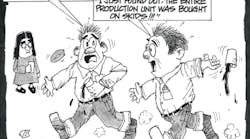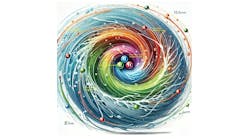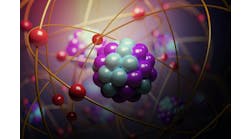This Control Talk column appeared in the August 2018 print edition of Control. To read more Control Talk columns click here or read the Control Talk blog here.
Greg: Measurements are our only window into what a process is doing, plus, you can’t control something if you’re not measuring it. There have been great advancements in measurement technology. Smart transmitters have increased accuracy an order of magnitude or more, and drift is so slow that calibration intervals can be significantly extended. However, a measurement is only as good as its installation. Not enough knowledge is published or presented on how to make sure the installation doesn’t limit performance or create maintenance and reliability issues. Here, Hunter Vegas and I (cofounders of the ISA Mentor Program) offer what we think is important. The newest resource to our ISA Mentor Program, Daniel Warren, has stepped up to offer his personal experiences to help guide our group. Daniel has over 35 years of experience as a senior instrument and electrical design specialist in oil, gas, chemical, food, mining, utilities, water & wastewater, and various pulp & paper facilities, and is the owner of D.M.W Instrumentation Consulting Services Ltd.
The most common flow and level measurements often use differential pressure (DP) transmitters with two impulse lines for flow, and one impulse and an equalization line for level. Pressure drops (e.g., column trays and across filters to detect fouling) and pressure rises in the plant (e.g., compressor suction to discharge to control surge) are also measured by a DP with two impulse lines. Many pressures must also be measured and controlled (e.g., boilers, columns, evaporators, furnaces, reactors, etc.). Gauge pressure transmitters vent the low side. Absolute pressure transmitters have the low side sealed with a full vacuum. Gauge and absolute pressure transmitters (PT) have a single impulse line. Consequently, a production unit can have thousands of impulse lines that are often the weakest link.
One large company had an objective to eliminate impulse lines and equalization lines by direct mounting of all types of pressure transmitters. This required separate transmitters at the bottom and top of a vessel to measure liquid head to compensate for tank operating pressure, and only works if the transmitter errors for each span are sufficiently less than the liquid head, ruling out high operating pressures. For many practical reasons as well as safety and accessibility, most companies still use impulse and equalization lines. The location and type of process connection and installation of these lines and block-and-bleeds can make or break an installation.
The DP and PT installation method and location should be designed to:
- Prevent a non-representative process variable at the transmitter,
- Prevent extraneous effects at the transmitter,
- Keep the fluid density, composition and phase the same to both sides of DP transmitter,
- Minimize accumulation of solids and bubbles,
- Minimize plugging, coating, corrosion, and fouling of the impulse lines,
- Minimize time lag(s) from impulse lines to the transmitter,
- Maximize signal-to-noise ratio, and
- Enable calibration and maintenance of the transmitter.
The accompanying figures provide a general idea of commonly-used DP and PT installations—read on to gain a better idea of what is really needed and the possible exceptions.
The impulse and equalization lines, valves and manifolds, as well as the transmitter, must have all wetted surfaces, including gaskets, O-rings and seals, constructed of materials that can withstand the worst process scenario. This could include corrosion, temperature swings, sudden pressure and vacuum swings, mechanical impact (hammering), clean-out procedures, etc.
Let’s first address measurement of gases. The goal is to ensure only gases enter the lines, and any liquid drains back into the process. The transmitter must be mounted above the process connections with a uniform slope of at least 1 foot of elevation change for every 10 feet of length, with a greater slope being generally advantageous. For horizontal pipelines, the process connections should be at the top. For vertical pipelines, the process connections are on the same side as the transmitter. A vent at the DP transmitter may be useful for venting the accumulation of low-density gases (e.g., inerts) and for transmitter maintenance.
The line lengths should be minimized when measurement speed of response is important. The time lag from gas-filled impulse lines can be approximated from extensive data that was developed for the time lags of pneumatic signal lines. The time lag from impulse lines completely filled with liquid is similar to that of capillary systems, and generally significantly less than that from gas-filled impulse lines.
Hunter: Another potential problem with gas installations is gas condensation. If the boiling point of the gas at maximum operating pressures is less than ambient temperature, the gases can condense in the impulse line and cause intermittent negative pressure spikes. In this case, the process tubing must be heat-traced to eliminate this issue. Note that steam also can condense, but this case is handled differently. (See steam section below.)
Daniel: I have seen a number of cases where piping has not been installed adequately to ensure a sufficient slope for gravity drainage. I have also seen lines that are damaged and twisted when other mechanical components are installed as an afterthought. I have “blow-down” lines installed for gas venting when isolating and venting a transmitter. This also gives me a location to tie in a purge to blow any particulate, oils or condensate back into the process line.
Greg: When measuring liquids or steam, you need to ensure the lines are equal in length, and filled with liquid that has the same density and no phase changes. The transmitter must be mounted below the process connections with a uniform slope of at least 1 foot in elevation for every 10 feet of length. The process connections should be on the same side of the transmitter for both horizontal and vertical pipelines. For horizontal pipelines, process connections below horizontal can cause solids accumulation, and above horizontal can cause bubble entrapment and loss of liquid fill when a line is not completely full and pressurized. Elbows should be minimized and never be in opposite directions. A vertical valve after the block valve at the process connection is suggested to enable venting of vapors and gases and for filling and flushing of the lines. Valves at the transmitter should enable flushing and draining the lines and transmitter.
Heat tracing must provide enough heat to prevent freezing on the coldest day with the coldest fluid, but doesn’t overheat the lines and cause flashing (vaporization or boiling) of the fluid on the hottest day with the hottest fluid.
Hunter: It’s very important that the tubing slope continuously from the process connection to the transmitter. Any high point along the way can trap vapors and cause an improper reading. Also, the transmitter connections usually branch off the main impulse run. This is done so if there are any solids in the impulse line, they’ll drop into the line section above the blowdown valves and not impact the pressure measurement at the transmitter.
Daniel: The other thing to take into consideration is the liquid itself. The process conditions and product will make a difference in the materials and installation. As an example, what is used for water may not be suitable for liquid natural gas (LNG), diluent, chlorine, etc. Each of these are requires certain materials for wetted parts (tubing, diaphragms, O-rings, gaskets, etc.) and it’s always best to confirm the requirements with the manufacturers’ tables. The other thing to consider is the temperature and the specific gravity. The rangeability as well as the materials themselves may put a limitation on what can be used to accurately measure that particular process.
Greg: What more do we need to know about steam installations?
Hunter: One might consider steam a “gas” and mount the transmitter above the process line with a heat-traced line to avoid condensation. However, most transmitters cannot handle the process temperatures and will fail in short order. Therefore, a typical steam installation will mount the transmitter below the line, let the steam condense, and thus protect the transmitter from the high temperatures. As long as both legs are equally filled, the water in the line will not impact the DP reading, but it will cause an offset for a pressure transmitter that must be calibrated out. You also need to freeze-protect the impulse lines, and keep them warm enough to avoid freezing but cold enough to ensure the steam will condense.
Daniel: You don't have to wait for the steam to condense to fill the lines during commissioning. Distilled water can be used for this purpose. I have also used glycol to fill the lines when setting up transmitters in cold-climate locations. Seal pots are more of an old school practice. Their primary use is to act as a barrier between a harmful process, such as a corrosive gas/liquid or steam, and transmitter.
Greg: Purged lines are kind of a last resort when fouling, solids and polymerization are a major concern. Diaphragm seals are an option to eliminate impulse lines. However, there are many installation and performance concerns with purged lines, bubblers and capillary systems that will be addressed in the September column. Alternatively, more advanced technologies should be considered that offer greater accuracy and require much less maintenance, such as Coriolis meters for flow and radar for level.
The ability to calibrate and maintain the DP installation generally requires the vent/fill/flush and drain valves mentioned above, and a manifold or equivalent piping of impulse lines that enable the same pressure be applied to both sides of the DP for zeroing. The valves in the lines and manifold must also allow the transmitter to be safely removed with no exposure to the process fluid.
Daniel: How you calibrate a transmitter also depends on how it was installed and the type (style) of transmitter. I have seen a number of skid-mounted transmitters (and older installations) that are not properly installed (isolated) to allow for a zero and/or span adjustment. It’s also easier to do a bench calibration as compared to a field calibration. A field calibration can be cumbersome, especially if you must have an assortment of tools and test equipment (air or nitrogen cylinders, hand pumps, etc.). Also, testing is limited when you are dealing with an older style of DP as compared to the smart versions.
Greg: Some transmitters can detect changes in phase and plugging in impulse lines. What diagnostics have you seen that are helpful in determining if a transmitter has a problem?
Daniel: The older style of transmitters didn’t really have anything to go by other than watching to see if there were any ongoing process changes. You could set up performance criteria, usually through third-party software or via data historian, to monitor several process parameters. If you’re really concerned, you can install more than one transmitter to watch as a backup of the process reading.
Today things are different and I have seen a method that monitors the high-frequency component of a measurement signal (commonly referred to as noise) to detect plugging conditions in fluid flow systems monitored by DP-based sensors. This high-frequency component has contributions from the process factors like disturbances and user actions, and random effects like turbulence.
Greg: Pressure measurements that are a fraction of an inch of water column are often excessively noisy and inaccurate due to velocity effects or impingement of particles. Probes whose slot is facing away from the flow can help reduce these problems. Also, there may be a furnace, kiln or dryer pressure location where velocity and particles are less of an issue.
Hunter: Be very careful with the installations here. The slightest bit of water collection in a line will have enormous impacts on the pressure reading.
Greg: Recently, I was asked to review and fix a two-stage neutralization system on a skid. The whitepaper by the expert associated with the supplier that was supposedly the design basis had some good points that looked like they came out of my ISA book, Advanced pH Measurement and Control. The skid was, unfortunately, a disaster and unsalvageable, violating many of the few good points in the whitepaper. The equipment and piping design and electrode location suffered from too much dead time and noise from extremely poor mixing in an application with a steep titration curve from a strong acid and strong base. The electrodes were prone to stagnation and not realistically removable. The control algorithms were special with little documentation and support on how to adjust the many parameters for a particular application initially set based on a theoretical titration curve. What have you seen and had to do for skids?
Daniel: Skids present a situation and consideration all their own. Yes, the manufacturer has built a number of them (perhaps hundreds), but do they meet the required specification of the client or site? I have been to a number of shops and mod yards that ask for exceptions because they’ve substituted items based on availability, cost and other factors. Some items may be considered acceptable, but not everything is negotiable. You must make sure that the manufacturer was given the specifications for what is and isn’t acceptable, and then carefully review the actual installation of the devices. I have seen a number of times where the skid builder has not followed the site or manufacturers’ standards, and they may not have even followed their own design criteria. Then the individual must make a call to have it repaired before being shipped, or to have the vendor come to site to make the repairs. I have also had the dubious honor of receiving a skid with the instruments and associated loose components shipped in boxes. (As they say, “some assembly required.”) Regardless of how the skid shows up, at the end of the day it must meet the specifications, and all the devices furnished or added (as needed) must meet the required design standards.
Hunter: Always check out a skid before it’s shipped (and obviously, before they have been paid), and send someone who knows what to look for. If there are issues, you can demand they be fixed prior to shipping. Your negotiating position falls precipitously once it arrives on your site, and becomes nonexistent once they have been paid.
Greg: I have the API RP 550 Manual on Installation of Refinery Instruments and Control Systems Part 1 that provides guidance. What are some good resources in terms of standards or publications?
Daniel: In most cases, especially in Canada, clients prefer that we used their standards, which come from API, ASME, ARC, NFPA and a host of others including some European standards and TUV for safety instrumented systems (SIS).
Greg: We look to Hunter here for some final words of wisdom.
Hunter: Many companies have spent significant money generating installation details, but unfortunately, it still requires a knowledgeable person to determine if a particular detail is appropriate for a given instrument. The ambient conditions and the process often require some modification to the “standard” design. But even if an installation is straight off the detail drawing, that hardly means the impulse lines will get installed correctly. Installers often make errors or simply ignore the prints entirely. High- and low-side tubing gets swapped, tubing fittings are not tightened, isolation and blowdown valves are left out, the wrong materials are used, etc. And even when installed correctly, it is fairly common for another craft to come in later and bend up the impulse lines that were perfectly sloped before.
To ensure the installation is correct and in good condition, the person responsible for the automation project field instrumentation must have the understanding and perception to find and fix anything that can hinder performance and reliability. All of the potential problems must be diligently identified, communicated and corrected. Inspection must be done right before commissioning to catch any last-minute damage.
Greg: We look forward to restarting our ISA Mentor Program Webinars with Daniel. If you would like to join the ISA Mentor Program or attend or present a Webinar, please contact Rick Zabel at ISA.
Top 10 things you don't want to hear about your differential pressure (DP) installation
10. What happens in the field stays in the field (like Las Vegas).
9. We went with our first impulse on impulse lines
8. Our transmitters are so reliable, we don't need to be concerned about maintenance.
7. We learned nothing on DP installation in our university course on control, so it must not be an issue.
6. Just crank up the steam to the heat tracing.
5. To minimize spares, all transmitters have the same material of construction and calibration spans.
4. To facilitate maintenance, we mounted all the transmitters in the shop.
3. The supplier says you can simply trust them because their engineers have college degrees.
2. There are no installation details because we heard "the devil is in the details."
1. By going with skids, we saved a lot of capital and then operating costs by not being able to run the unit.







